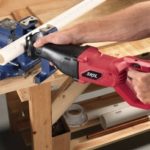Corded vs Cordless Reciprocating Saw: Which is Right for Your Needs?
-

- Last updated:


Regardless of the type, choosing between cordless and corded tools is a debate that will likely go on for centuries. There will always be those who believe a corded saw is the only way to go and others who think you’re crazy to use anything other than cordless. There are some significant differences between a corded and a cordless reciprocating saw. We’ll give you a basic rundown of the differences you can expect between these two saws and how to determine which one will work best for you.
Corded Reciprocating Saw Overview
 A corded reciprocating saw is a saw that uses a back-and-forth repetitive motion to cut through materials. It will have a power cord extending from the back or bottom of the saw.
A corded reciprocating saw is a saw that uses a back-and-forth repetitive motion to cut through materials. It will have a power cord extending from the back or bottom of the saw.
Basic Functions
A corded reciprocating saw is used primarily for demolition and heavy-duty projects. You can use corded reciprocating saws in tight spaces, and they generally work well when doing plumbing work or PVC cutting.
Types of Cuts
The cut you get with a corded reciprocating saw will be a bit rough compared to a circular saw. You can cut on an angle with this saw, but you will have to hold the saw steady and follow the line yourself. You cannot set the reciprocating saw to cut at the exact angle that you want.
Blades
Many blades are available for a corded reciprocating saw. There are blades specifically designed for wood, plastic, and metal. You must match the proper blade to the material you are cutting, or you will quickly snap the blade. Corded reciprocating saws have blades available in several lengths, depending on the project you are working on. Blades are generally 3–12 inches long, but the most common length is 6 inches.
Teeth per inch (TPI) is the most important spec of a reciprocating saw blade. Low TPI cuts faster but with rougher edges and is best suited for cutting wood. High TPI results in slower cutting but gives you a smoother edge, which is ideal for cutting metal.
Safety
Price
- Lots of power
- Efficient and quick
- Great for demolition work
- Affordable
- Not very safe
- Need an electrical outlet to use
Cordless Reciprocating Saw Overview
 A cordless reciprocating saw has one significant difference when compared to the corded one, and that is the source of power. A cordless saw uses batteries for power as opposed to the electrical power used with the corded option.
A cordless reciprocating saw has one significant difference when compared to the corded one, and that is the source of power. A cordless saw uses batteries for power as opposed to the electrical power used with the corded option.
See Also: Our reviews of the best cordless reciprocating saws
Basic Functions
The cordless saw’s primary functions are similar to that of the corded. The primary difference you will find with this saw is its portability. If you are working on pruning at the back end of your property where there is no power, the cordless reciprocating saw will not require a lengthy extension cord.
Types of Cuts
The cordless can make the same types of cuts as the cordless, except they may take longer. If you are cutting through a thick piece of wood, you will want a corded saw. The cordless is ideal for detailed cuts because it’s less powerful than the corded model.
Blades
The blades of the corded and cordless saws are the same.
Safety
Price
- Very portable
- Can use it wherever you need it
- Stable cuts
- Good for a beginner
- Does not have as much power
- Will struggle with thicker materials
Which Saw is Right for Your Needs?
Determining which of these saws will work for your needs will come down to two basic questions. Where do you want to use the saw? And what are you using it for?
Location

Material
Corded and cordless reciprocating saws are capable of cutting various types of material. However, if you have thick wood or metal to cut through, you need the corded version. The difference in power is going to make the job much more comfortable. When cordless saws face complicated cutting tasks, they drain their battery quickly.
Weight
A cordless reciprocating saw is a bit heavier than a corded one. The weight of the battery tends to weigh the saw down quite a bit. This is not an issue if you plan to pick up the saw and make a few minor cuts. It becomes an issue for workers who must have a saw in their hands most of the day or continually lug it around a job site.
Conclusion
It is impossible to say which of these two saws, the cordless or the corded reciprocating saw, is better. Both options have their positives and negatives. Be sure to carefully analyze your sawing skills and the task you have at hand before making any final decisions. Try not to use the price as the determining factor when choosing a reciprocating saw. The differences are not enough that you should use it as your determining factor.
- See Also: 5 Best Air Reciprocating Saws
Contents



